Analyzing Child Abuse: Level 3 Project on Protection Case Studies
VerifiedAdded on 2023/06/07
|19
|8081
|245
Case Study
AI Summary
This assignment presents a series of case studies involving potential child abuse scenarios. Each scenario requires identifying the type of abuse, associated signs and symptoms, contributing factors, and appropriate actions to take. The case studies cover various forms of abuse, including neglect, physical abuse, and psychological abuse. The responses involve understanding legal and ethical responsibilities, appropriate questioning techniques, documentation procedures, and reporting protocols. The assignment emphasizes the importance of emotional support for the child, collaboration with relevant authorities, and preventative measures to safeguard children's well-being. The student provides detailed analysis and actionable steps based on the information presented in each scenario.
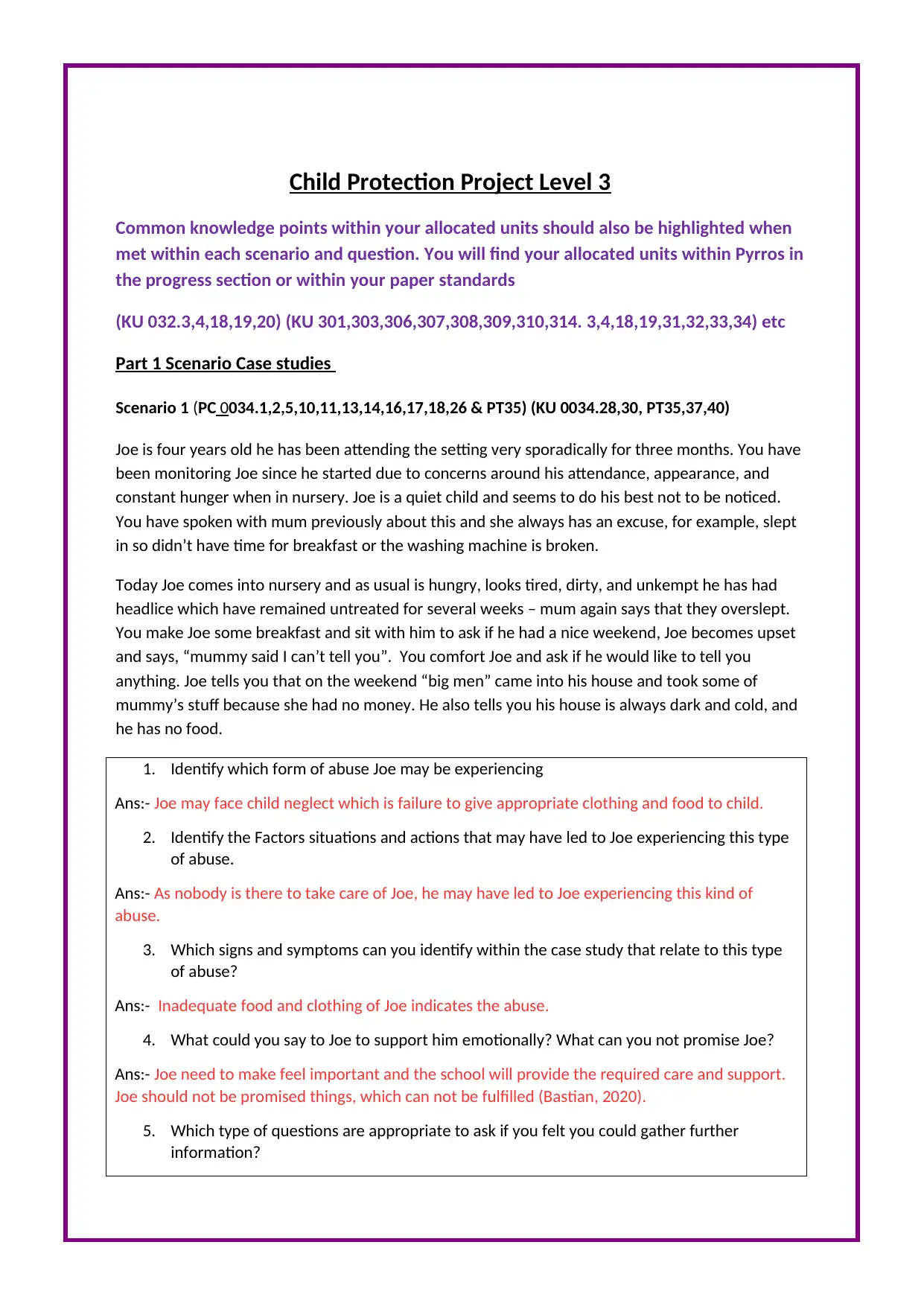
Child Protection Project Level 3
Common knowledge points within your allocated units should also be highlighted when
met within each scenario and question. You will find your allocated units within Pyrros in
the progress section or within your paper standards
(KU 032.3,4,18,19,20) (KU 301,303,306,307,308,309,310,314. 3,4,18,19,31,32,33,34) etc
Part 1 Scenario Case studies
Scenario 1 (PC 0034.1,2,5,10,11,13,14,16,17,18,26 & PT35) (KU 0034.28,30, PT35,37,40)
Joe is four years old he has been attending the setting very sporadically for three months. You have
been monitoring Joe since he started due to concerns around his attendance, appearance, and
constant hunger when in nursery. Joe is a quiet child and seems to do his best not to be noticed.
You have spoken with mum previously about this and she always has an excuse, for example, slept
in so didn’t have time for breakfast or the washing machine is broken.
Today Joe comes into nursery and as usual is hungry, looks tired, dirty, and unkempt he has had
headlice which have remained untreated for several weeks – mum again says that they overslept.
You make Joe some breakfast and sit with him to ask if he had a nice weekend, Joe becomes upset
and says, “mummy said I can’t tell you”. You comfort Joe and ask if he would like to tell you
anything. Joe tells you that on the weekend “big men” came into his house and took some of
mummy’s stuff because she had no money. He also tells you his house is always dark and cold, and
he has no food.
1. Identify which form of abuse Joe may be experiencing
Ans:- Joe may face child neglect which is failure to give appropriate clothing and food to child.
2. Identify the Factors situations and actions that may have led to Joe experiencing this type
of abuse.
Ans:- As nobody is there to take care of Joe, he may have led to Joe experiencing this kind of
abuse.
3. Which signs and symptoms can you identify within the case study that relate to this type
of abuse?
Ans:- Inadequate food and clothing of Joe indicates the abuse.
4. What could you say to Joe to support him emotionally? What can you not promise Joe?
Ans:- Joe need to make feel important and the school will provide the required care and support.
Joe should not be promised things, which can not be fulfilled (Bastian, 2020).
5. Which type of questions are appropriate to ask if you felt you could gather further
information?
Common knowledge points within your allocated units should also be highlighted when
met within each scenario and question. You will find your allocated units within Pyrros in
the progress section or within your paper standards
(KU 032.3,4,18,19,20) (KU 301,303,306,307,308,309,310,314. 3,4,18,19,31,32,33,34) etc
Part 1 Scenario Case studies
Scenario 1 (PC 0034.1,2,5,10,11,13,14,16,17,18,26 & PT35) (KU 0034.28,30, PT35,37,40)
Joe is four years old he has been attending the setting very sporadically for three months. You have
been monitoring Joe since he started due to concerns around his attendance, appearance, and
constant hunger when in nursery. Joe is a quiet child and seems to do his best not to be noticed.
You have spoken with mum previously about this and she always has an excuse, for example, slept
in so didn’t have time for breakfast or the washing machine is broken.
Today Joe comes into nursery and as usual is hungry, looks tired, dirty, and unkempt he has had
headlice which have remained untreated for several weeks – mum again says that they overslept.
You make Joe some breakfast and sit with him to ask if he had a nice weekend, Joe becomes upset
and says, “mummy said I can’t tell you”. You comfort Joe and ask if he would like to tell you
anything. Joe tells you that on the weekend “big men” came into his house and took some of
mummy’s stuff because she had no money. He also tells you his house is always dark and cold, and
he has no food.
1. Identify which form of abuse Joe may be experiencing
Ans:- Joe may face child neglect which is failure to give appropriate clothing and food to child.
2. Identify the Factors situations and actions that may have led to Joe experiencing this type
of abuse.
Ans:- As nobody is there to take care of Joe, he may have led to Joe experiencing this kind of
abuse.
3. Which signs and symptoms can you identify within the case study that relate to this type
of abuse?
Ans:- Inadequate food and clothing of Joe indicates the abuse.
4. What could you say to Joe to support him emotionally? What can you not promise Joe?
Ans:- Joe need to make feel important and the school will provide the required care and support.
Joe should not be promised things, which can not be fulfilled (Bastian, 2020).
5. Which type of questions are appropriate to ask if you felt you could gather further
information?
Paraphrase This Document
Need a fresh take? Get an instant paraphrase of this document with our AI Paraphraser
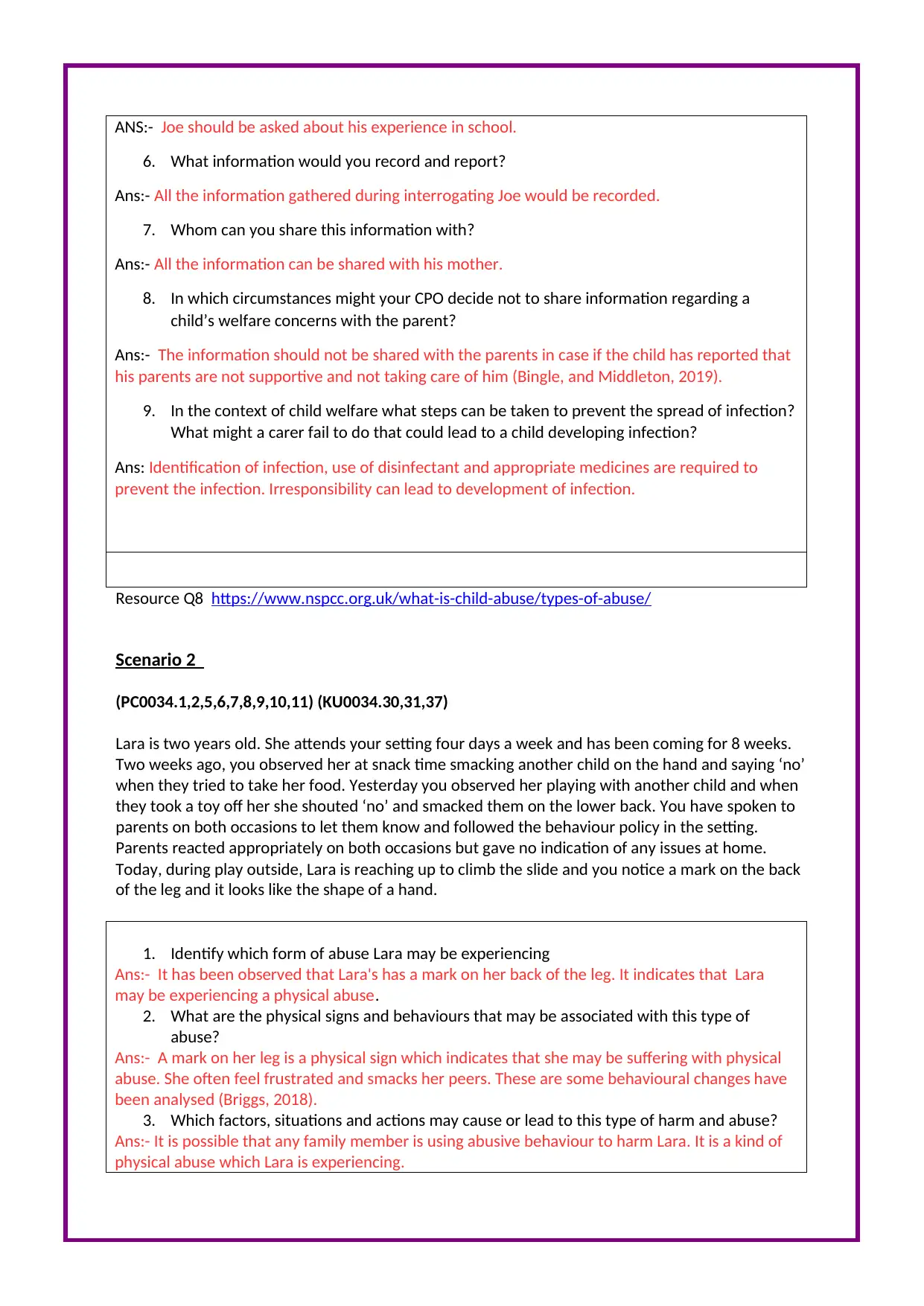
ANS:- Joe should be asked about his experience in school.
6. What information would you record and report?
Ans:- All the information gathered during interrogating Joe would be recorded.
7. Whom can you share this information with?
Ans:- All the information can be shared with his mother.
8. In which circumstances might your CPO decide not to share information regarding a
child’s welfare concerns with the parent?
Ans:- The information should not be shared with the parents in case if the child has reported that
his parents are not supportive and not taking care of him (Bingle, and Middleton, 2019).
9. In the context of child welfare what steps can be taken to prevent the spread of infection?
What might a carer fail to do that could lead to a child developing infection?
Ans: Identification of infection, use of disinfectant and appropriate medicines are required to
prevent the infection. Irresponsibility can lead to development of infection.
Resource Q8 https://www.nspcc.org.uk/what-is-child-abuse/types-of-abuse/
Scenario 2
(PC0034.1,2,5,6,7,8,9,10,11) (KU0034.30,31,37)
Lara is two years old. She attends your setting four days a week and has been coming for 8 weeks.
Two weeks ago, you observed her at snack time smacking another child on the hand and saying ‘no’
when they tried to take her food. Yesterday you observed her playing with another child and when
they took a toy off her she shouted ‘no’ and smacked them on the lower back. You have spoken to
parents on both occasions to let them know and followed the behaviour policy in the setting.
Parents reacted appropriately on both occasions but gave no indication of any issues at home.
Today, during play outside, Lara is reaching up to climb the slide and you notice a mark on the back
of the leg and it looks like the shape of a hand.
1. Identify which form of abuse Lara may be experiencing
Ans:- It has been observed that Lara's has a mark on her back of the leg. It indicates that Lara
may be experiencing a physical abuse.
2. What are the physical signs and behaviours that may be associated with this type of
abuse?
Ans:- A mark on her leg is a physical sign which indicates that she may be suffering with physical
abuse. She often feel frustrated and smacks her peers. These are some behavioural changes have
been analysed (Briggs, 2018).
3. Which factors, situations and actions may cause or lead to this type of harm and abuse?
Ans:- It is possible that any family member is using abusive behaviour to harm Lara. It is a kind of
physical abuse which Lara is experiencing.
6. What information would you record and report?
Ans:- All the information gathered during interrogating Joe would be recorded.
7. Whom can you share this information with?
Ans:- All the information can be shared with his mother.
8. In which circumstances might your CPO decide not to share information regarding a
child’s welfare concerns with the parent?
Ans:- The information should not be shared with the parents in case if the child has reported that
his parents are not supportive and not taking care of him (Bingle, and Middleton, 2019).
9. In the context of child welfare what steps can be taken to prevent the spread of infection?
What might a carer fail to do that could lead to a child developing infection?
Ans: Identification of infection, use of disinfectant and appropriate medicines are required to
prevent the infection. Irresponsibility can lead to development of infection.
Resource Q8 https://www.nspcc.org.uk/what-is-child-abuse/types-of-abuse/
Scenario 2
(PC0034.1,2,5,6,7,8,9,10,11) (KU0034.30,31,37)
Lara is two years old. She attends your setting four days a week and has been coming for 8 weeks.
Two weeks ago, you observed her at snack time smacking another child on the hand and saying ‘no’
when they tried to take her food. Yesterday you observed her playing with another child and when
they took a toy off her she shouted ‘no’ and smacked them on the lower back. You have spoken to
parents on both occasions to let them know and followed the behaviour policy in the setting.
Parents reacted appropriately on both occasions but gave no indication of any issues at home.
Today, during play outside, Lara is reaching up to climb the slide and you notice a mark on the back
of the leg and it looks like the shape of a hand.
1. Identify which form of abuse Lara may be experiencing
Ans:- It has been observed that Lara's has a mark on her back of the leg. It indicates that Lara
may be experiencing a physical abuse.
2. What are the physical signs and behaviours that may be associated with this type of
abuse?
Ans:- A mark on her leg is a physical sign which indicates that she may be suffering with physical
abuse. She often feel frustrated and smacks her peers. These are some behavioural changes have
been analysed (Briggs, 2018).
3. Which factors, situations and actions may cause or lead to this type of harm and abuse?
Ans:- It is possible that any family member is using abusive behaviour to harm Lara. It is a kind of
physical abuse which Lara is experiencing.
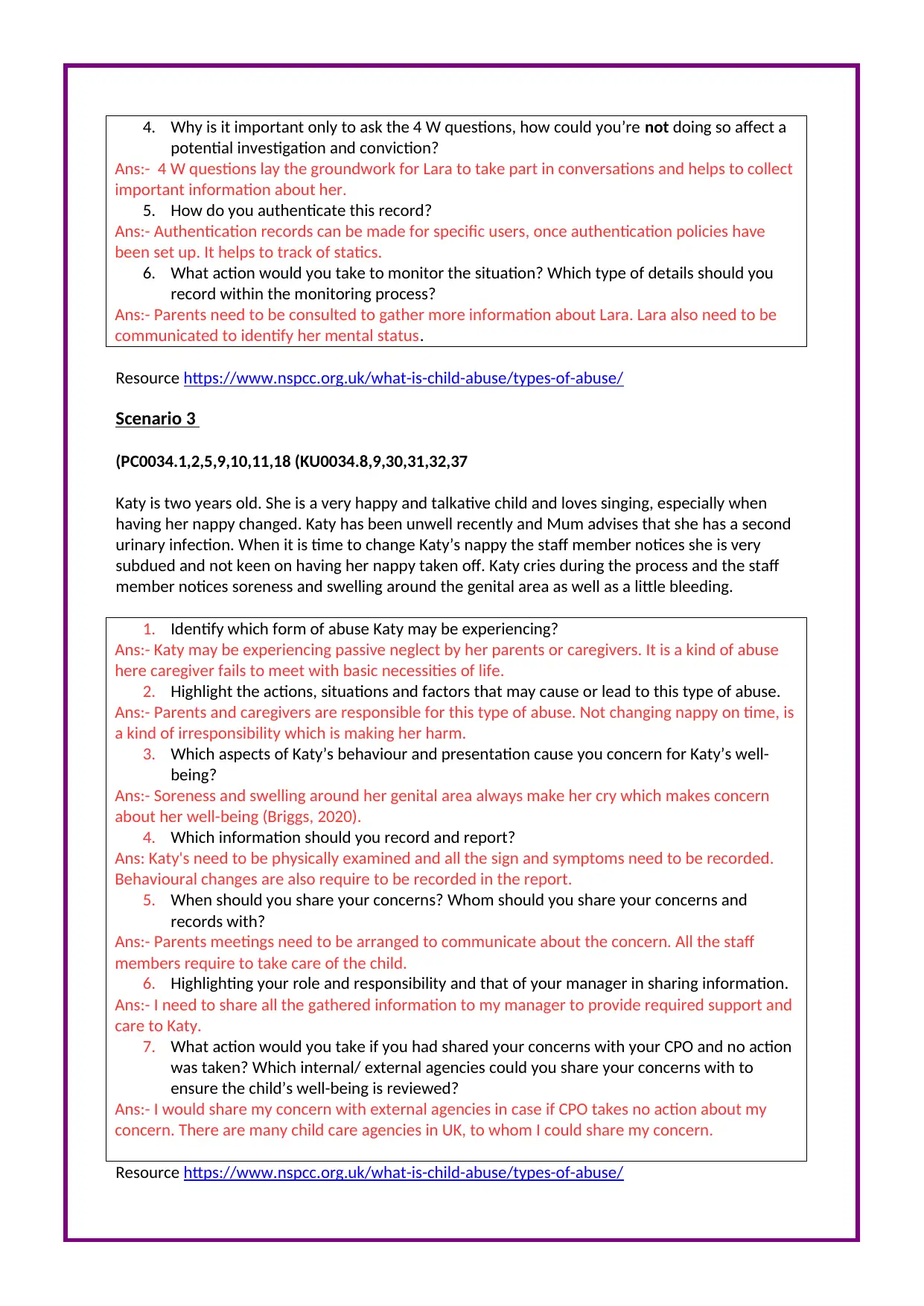
4. Why is it important only to ask the 4 W questions, how could you’re not doing so affect a
potential investigation and conviction?
Ans:- 4 W questions lay the groundwork for Lara to take part in conversations and helps to collect
important information about her.
5. How do you authenticate this record?
Ans:- Authentication records can be made for specific users, once authentication policies have
been set up. It helps to track of statics.
6. What action would you take to monitor the situation? Which type of details should you
record within the monitoring process?
Ans:- Parents need to be consulted to gather more information about Lara. Lara also need to be
communicated to identify her mental status.
Resource https://www.nspcc.org.uk/what-is-child-abuse/types-of-abuse/
Scenario 3
(PC0034.1,2,5,9,10,11,18 (KU0034.8,9,30,31,32,37
Katy is two years old. She is a very happy and talkative child and loves singing, especially when
having her nappy changed. Katy has been unwell recently and Mum advises that she has a second
urinary infection. When it is time to change Katy’s nappy the staff member notices she is very
subdued and not keen on having her nappy taken off. Katy cries during the process and the staff
member notices soreness and swelling around the genital area as well as a little bleeding.
1. Identify which form of abuse Katy may be experiencing?
Ans:- Katy may be experiencing passive neglect by her parents or caregivers. It is a kind of abuse
here caregiver fails to meet with basic necessities of life.
2. Highlight the actions, situations and factors that may cause or lead to this type of abuse.
Ans:- Parents and caregivers are responsible for this type of abuse. Not changing nappy on time, is
a kind of irresponsibility which is making her harm.
3. Which aspects of Katy’s behaviour and presentation cause you concern for Katy’s well-
being?
Ans:- Soreness and swelling around her genital area always make her cry which makes concern
about her well-being (Briggs, 2020).
4. Which information should you record and report?
Ans: Katy's need to be physically examined and all the sign and symptoms need to be recorded.
Behavioural changes are also require to be recorded in the report.
5. When should you share your concerns? Whom should you share your concerns and
records with?
Ans:- Parents meetings need to be arranged to communicate about the concern. All the staff
members require to take care of the child.
6. Highlighting your role and responsibility and that of your manager in sharing information.
Ans:- I need to share all the gathered information to my manager to provide required support and
care to Katy.
7. What action would you take if you had shared your concerns with your CPO and no action
was taken? Which internal/ external agencies could you share your concerns with to
ensure the child’s well-being is reviewed?
Ans:- I would share my concern with external agencies in case if CPO takes no action about my
concern. There are many child care agencies in UK, to whom I could share my concern.
Resource https://www.nspcc.org.uk/what-is-child-abuse/types-of-abuse/
potential investigation and conviction?
Ans:- 4 W questions lay the groundwork for Lara to take part in conversations and helps to collect
important information about her.
5. How do you authenticate this record?
Ans:- Authentication records can be made for specific users, once authentication policies have
been set up. It helps to track of statics.
6. What action would you take to monitor the situation? Which type of details should you
record within the monitoring process?
Ans:- Parents need to be consulted to gather more information about Lara. Lara also need to be
communicated to identify her mental status.
Resource https://www.nspcc.org.uk/what-is-child-abuse/types-of-abuse/
Scenario 3
(PC0034.1,2,5,9,10,11,18 (KU0034.8,9,30,31,32,37
Katy is two years old. She is a very happy and talkative child and loves singing, especially when
having her nappy changed. Katy has been unwell recently and Mum advises that she has a second
urinary infection. When it is time to change Katy’s nappy the staff member notices she is very
subdued and not keen on having her nappy taken off. Katy cries during the process and the staff
member notices soreness and swelling around the genital area as well as a little bleeding.
1. Identify which form of abuse Katy may be experiencing?
Ans:- Katy may be experiencing passive neglect by her parents or caregivers. It is a kind of abuse
here caregiver fails to meet with basic necessities of life.
2. Highlight the actions, situations and factors that may cause or lead to this type of abuse.
Ans:- Parents and caregivers are responsible for this type of abuse. Not changing nappy on time, is
a kind of irresponsibility which is making her harm.
3. Which aspects of Katy’s behaviour and presentation cause you concern for Katy’s well-
being?
Ans:- Soreness and swelling around her genital area always make her cry which makes concern
about her well-being (Briggs, 2020).
4. Which information should you record and report?
Ans: Katy's need to be physically examined and all the sign and symptoms need to be recorded.
Behavioural changes are also require to be recorded in the report.
5. When should you share your concerns? Whom should you share your concerns and
records with?
Ans:- Parents meetings need to be arranged to communicate about the concern. All the staff
members require to take care of the child.
6. Highlighting your role and responsibility and that of your manager in sharing information.
Ans:- I need to share all the gathered information to my manager to provide required support and
care to Katy.
7. What action would you take if you had shared your concerns with your CPO and no action
was taken? Which internal/ external agencies could you share your concerns with to
ensure the child’s well-being is reviewed?
Ans:- I would share my concern with external agencies in case if CPO takes no action about my
concern. There are many child care agencies in UK, to whom I could share my concern.
Resource https://www.nspcc.org.uk/what-is-child-abuse/types-of-abuse/
⊘ This is a preview!⊘
Do you want full access?
Subscribe today to unlock all pages.

Trusted by 1+ million students worldwide
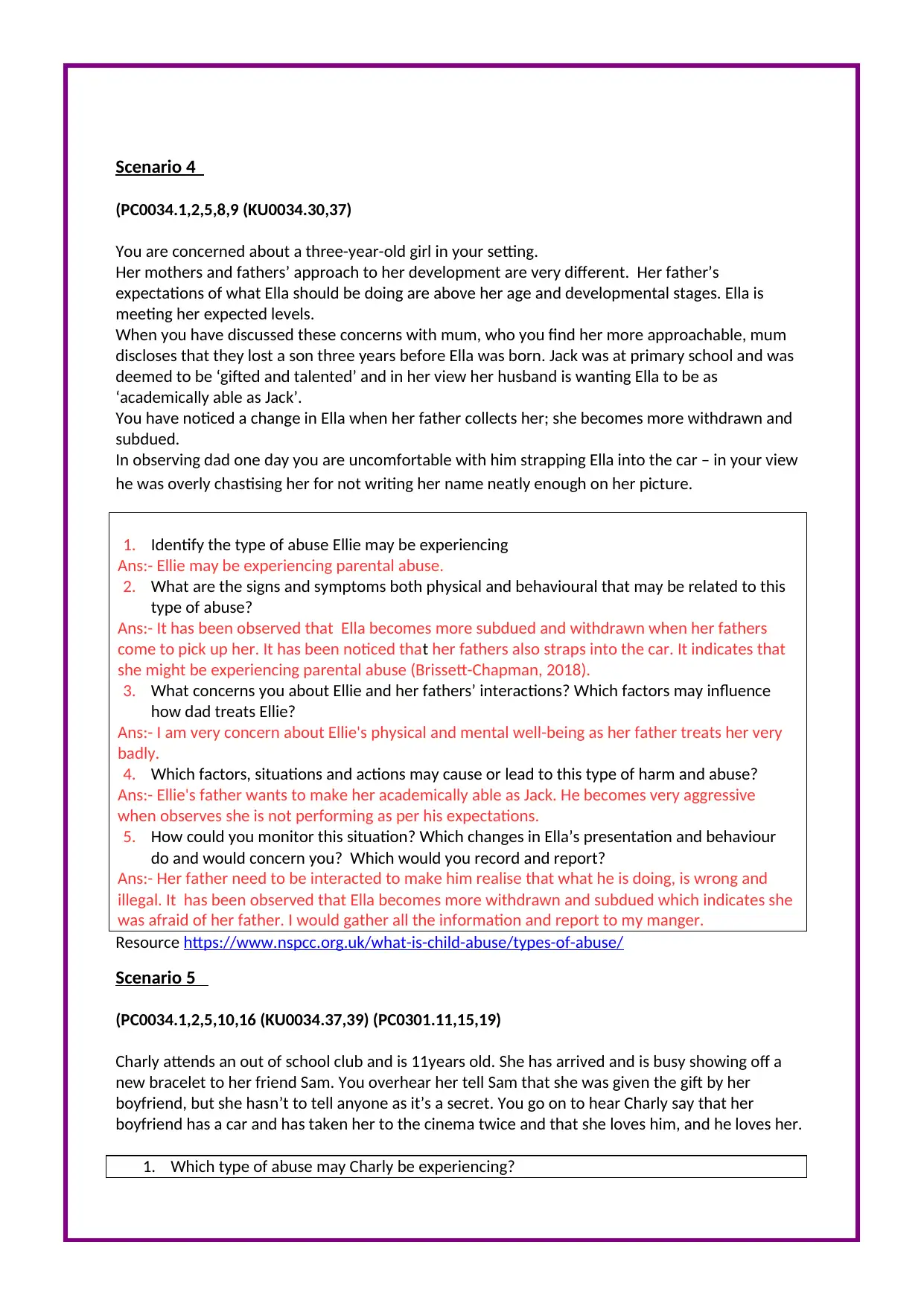
Scenario 4
(PC0034.1,2,5,8,9 (KU0034.30,37)
You are concerned about a three-year-old girl in your setting.
Her mothers and fathers’ approach to her development are very different. Her father’s
expectations of what Ella should be doing are above her age and developmental stages. Ella is
meeting her expected levels.
When you have discussed these concerns with mum, who you find her more approachable, mum
discloses that they lost a son three years before Ella was born. Jack was at primary school and was
deemed to be ‘gifted and talented’ and in her view her husband is wanting Ella to be as
‘academically able as Jack’.
You have noticed a change in Ella when her father collects her; she becomes more withdrawn and
subdued.
In observing dad one day you are uncomfortable with him strapping Ella into the car – in your view
he was overly chastising her for not writing her name neatly enough on her picture.
1. Identify the type of abuse Ellie may be experiencing
Ans:- Ellie may be experiencing parental abuse.
2. What are the signs and symptoms both physical and behavioural that may be related to this
type of abuse?
Ans:- It has been observed that Ella becomes more subdued and withdrawn when her fathers
come to pick up her. It has been noticed that her fathers also straps into the car. It indicates that
she might be experiencing parental abuse (Brissett-Chapman, 2018).
3. What concerns you about Ellie and her fathers’ interactions? Which factors may influence
how dad treats Ellie?
Ans:- I am very concern about Ellie's physical and mental well-being as her father treats her very
badly.
4. Which factors, situations and actions may cause or lead to this type of harm and abuse?
Ans:- Ellie's father wants to make her academically able as Jack. He becomes very aggressive
when observes she is not performing as per his expectations.
5. How could you monitor this situation? Which changes in Ella’s presentation and behaviour
do and would concern you? Which would you record and report?
Ans:- Her father need to be interacted to make him realise that what he is doing, is wrong and
illegal. It has been observed that Ella becomes more withdrawn and subdued which indicates she
was afraid of her father. I would gather all the information and report to my manger.
Resource https://www.nspcc.org.uk/what-is-child-abuse/types-of-abuse/
Scenario 5
(PC0034.1,2,5,10,16 (KU0034.37,39) (PC0301.11,15,19)
Charly attends an out of school club and is 11years old. She has arrived and is busy showing off a
new bracelet to her friend Sam. You overhear her tell Sam that she was given the gift by her
boyfriend, but she hasn’t to tell anyone as it’s a secret. You go on to hear Charly say that her
boyfriend has a car and has taken her to the cinema twice and that she loves him, and he loves her.
1. Which type of abuse may Charly be experiencing?
(PC0034.1,2,5,8,9 (KU0034.30,37)
You are concerned about a three-year-old girl in your setting.
Her mothers and fathers’ approach to her development are very different. Her father’s
expectations of what Ella should be doing are above her age and developmental stages. Ella is
meeting her expected levels.
When you have discussed these concerns with mum, who you find her more approachable, mum
discloses that they lost a son three years before Ella was born. Jack was at primary school and was
deemed to be ‘gifted and talented’ and in her view her husband is wanting Ella to be as
‘academically able as Jack’.
You have noticed a change in Ella when her father collects her; she becomes more withdrawn and
subdued.
In observing dad one day you are uncomfortable with him strapping Ella into the car – in your view
he was overly chastising her for not writing her name neatly enough on her picture.
1. Identify the type of abuse Ellie may be experiencing
Ans:- Ellie may be experiencing parental abuse.
2. What are the signs and symptoms both physical and behavioural that may be related to this
type of abuse?
Ans:- It has been observed that Ella becomes more subdued and withdrawn when her fathers
come to pick up her. It has been noticed that her fathers also straps into the car. It indicates that
she might be experiencing parental abuse (Brissett-Chapman, 2018).
3. What concerns you about Ellie and her fathers’ interactions? Which factors may influence
how dad treats Ellie?
Ans:- I am very concern about Ellie's physical and mental well-being as her father treats her very
badly.
4. Which factors, situations and actions may cause or lead to this type of harm and abuse?
Ans:- Ellie's father wants to make her academically able as Jack. He becomes very aggressive
when observes she is not performing as per his expectations.
5. How could you monitor this situation? Which changes in Ella’s presentation and behaviour
do and would concern you? Which would you record and report?
Ans:- Her father need to be interacted to make him realise that what he is doing, is wrong and
illegal. It has been observed that Ella becomes more withdrawn and subdued which indicates she
was afraid of her father. I would gather all the information and report to my manger.
Resource https://www.nspcc.org.uk/what-is-child-abuse/types-of-abuse/
Scenario 5
(PC0034.1,2,5,10,16 (KU0034.37,39) (PC0301.11,15,19)
Charly attends an out of school club and is 11years old. She has arrived and is busy showing off a
new bracelet to her friend Sam. You overhear her tell Sam that she was given the gift by her
boyfriend, but she hasn’t to tell anyone as it’s a secret. You go on to hear Charly say that her
boyfriend has a car and has taken her to the cinema twice and that she loves him, and he loves her.
1. Which type of abuse may Charly be experiencing?
Paraphrase This Document
Need a fresh take? Get an instant paraphrase of this document with our AI Paraphraser

Ans:- Charley may be experiencing psychological abuse as she tempt to be with her boyfriend just
because he gives her expensive gifts.
2. Which type of disclosure has been made?
Ans:- It has been disclosed that her boyfriend gives her gifts and has taken her for movie twice
(Falch Eriksen,and et.al 2021).‐
3. How could you gain more information from Charly? Which questions could you safely use
to gather more information?
Ans:- Attendance register is required to be checked to ensure is she coming school regularly. She
need to be asked about her plans after the school to ensure whether she is gain going with her
boyfriend.
4. If there were an older child who did not wish to make a verbal disclosure how could you
support them to do so using alternative method?
Ans:- A child who did not wish to make a verbal disclosure, requires to be motivated to talk about
in order to provide support and care.
5. Highlight the actions, situations and factors that may cause or lead to this type of abuse.
Ans:- It may be possible that Charley is not getting any emotional support from her family
members and getting emotionally attached with her boyfriend.
6. What are the signs and symptoms and behaviours you may observe associated with this
type of abuse?
Ans:- Charley is showing off her bracelet to her friend and started missing her classes just because
she is going for cinemas.
7. What are the features of a perpetrator of this type of abuse? Which behaviours may they
display?
Ans:- In this case, Charley's boyfriend has been analysed as perpetrator as he is giving her
expensive gifts and taken her for cinemas (Fay, 2021).
Resource https://www.nspcc.org.uk/what-is-child-abuse/types-of-abuse/
Scenario 6
(PC0034.10,16,14,17,18,19, PT20,22,23, PT27,28,29,30,31,32 33,34,35)
(KU0034.4, PT34, PT35,37)
Georgia is 10 years old and has arrived at an out of school club where you work very upset wearing
only one shoe and dragging her jacket which is covered in mud. When you ask Georgia what has
happened, she discloses she was attacked by 3 girls who have been bullying her in school and
online. The girls in question you are aware attend the school where your club is based. Georgia
discloses that the girls have been posting pictures of her online and labelling her as # Fat Pig they
have superimposed Georgia’s head onto the body of a pig. Georgia shares this image with you.
1. What type of abuse is Georgia experiencing? (There may be more than one form of
abuse identified within this case study)
Ans:- Georgia is experiencing online and physical abuse as she has been bulled by three girls and
they superimposed her head onto the body of a pig.
2. What is discrimination? What is the definition of discrimination?
Ans:- Discrimination refers to unfair judgement and treatment with a specific people or group of
people on the basis of their race, sexual orientation, gender and other characteristics.
because he gives her expensive gifts.
2. Which type of disclosure has been made?
Ans:- It has been disclosed that her boyfriend gives her gifts and has taken her for movie twice
(Falch Eriksen,and et.al 2021).‐
3. How could you gain more information from Charly? Which questions could you safely use
to gather more information?
Ans:- Attendance register is required to be checked to ensure is she coming school regularly. She
need to be asked about her plans after the school to ensure whether she is gain going with her
boyfriend.
4. If there were an older child who did not wish to make a verbal disclosure how could you
support them to do so using alternative method?
Ans:- A child who did not wish to make a verbal disclosure, requires to be motivated to talk about
in order to provide support and care.
5. Highlight the actions, situations and factors that may cause or lead to this type of abuse.
Ans:- It may be possible that Charley is not getting any emotional support from her family
members and getting emotionally attached with her boyfriend.
6. What are the signs and symptoms and behaviours you may observe associated with this
type of abuse?
Ans:- Charley is showing off her bracelet to her friend and started missing her classes just because
she is going for cinemas.
7. What are the features of a perpetrator of this type of abuse? Which behaviours may they
display?
Ans:- In this case, Charley's boyfriend has been analysed as perpetrator as he is giving her
expensive gifts and taken her for cinemas (Fay, 2021).
Resource https://www.nspcc.org.uk/what-is-child-abuse/types-of-abuse/
Scenario 6
(PC0034.10,16,14,17,18,19, PT20,22,23, PT27,28,29,30,31,32 33,34,35)
(KU0034.4, PT34, PT35,37)
Georgia is 10 years old and has arrived at an out of school club where you work very upset wearing
only one shoe and dragging her jacket which is covered in mud. When you ask Georgia what has
happened, she discloses she was attacked by 3 girls who have been bullying her in school and
online. The girls in question you are aware attend the school where your club is based. Georgia
discloses that the girls have been posting pictures of her online and labelling her as # Fat Pig they
have superimposed Georgia’s head onto the body of a pig. Georgia shares this image with you.
1. What type of abuse is Georgia experiencing? (There may be more than one form of
abuse identified within this case study)
Ans:- Georgia is experiencing online and physical abuse as she has been bulled by three girls and
they superimposed her head onto the body of a pig.
2. What is discrimination? What is the definition of discrimination?
Ans:- Discrimination refers to unfair judgement and treatment with a specific people or group of
people on the basis of their race, sexual orientation, gender and other characteristics.
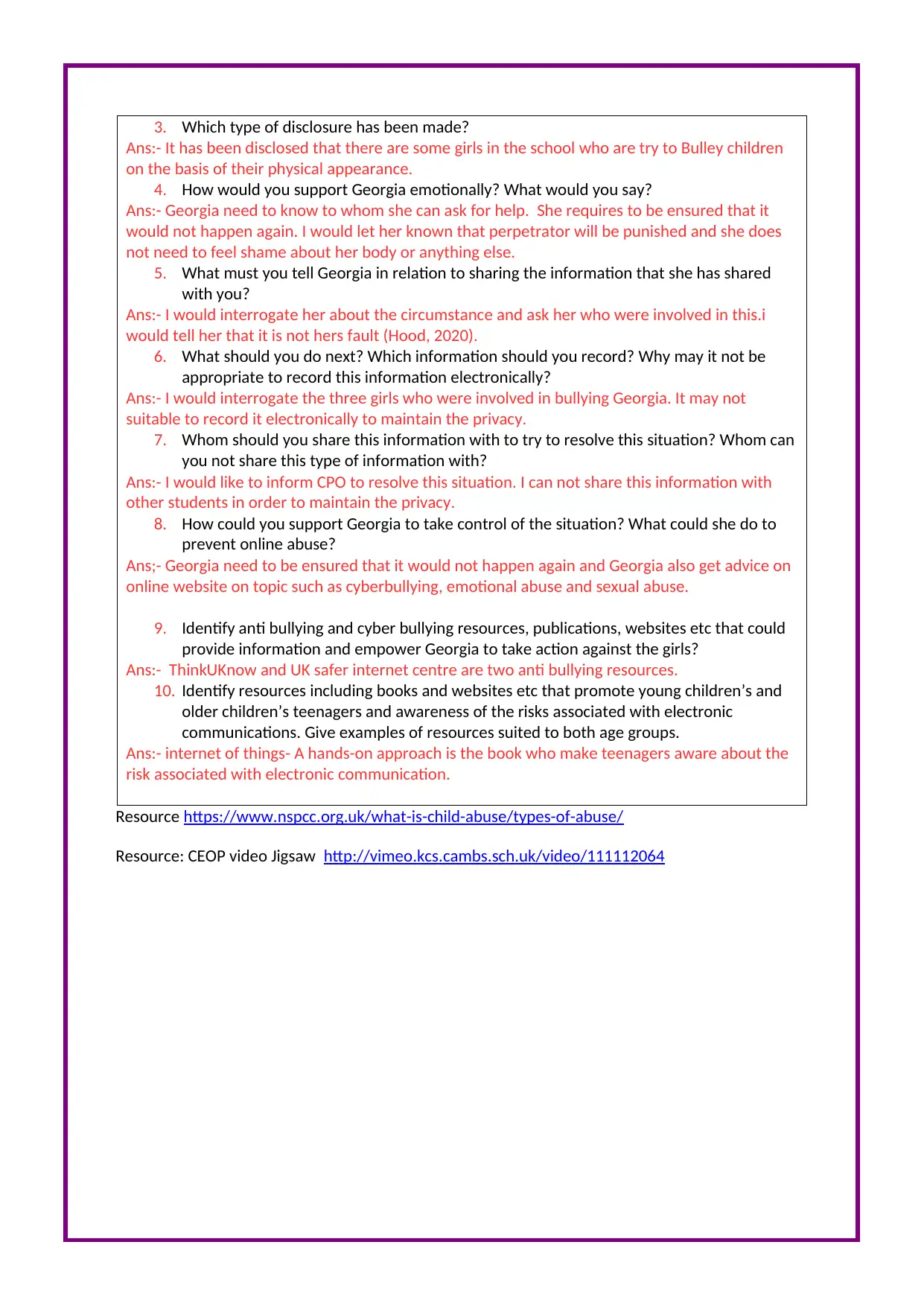
3. Which type of disclosure has been made?
Ans:- It has been disclosed that there are some girls in the school who are try to Bulley children
on the basis of their physical appearance.
4. How would you support Georgia emotionally? What would you say?
Ans:- Georgia need to know to whom she can ask for help. She requires to be ensured that it
would not happen again. I would let her known that perpetrator will be punished and she does
not need to feel shame about her body or anything else.
5. What must you tell Georgia in relation to sharing the information that she has shared
with you?
Ans:- I would interrogate her about the circumstance and ask her who were involved in this.i
would tell her that it is not hers fault (Hood, 2020).
6. What should you do next? Which information should you record? Why may it not be
appropriate to record this information electronically?
Ans:- I would interrogate the three girls who were involved in bullying Georgia. It may not
suitable to record it electronically to maintain the privacy.
7. Whom should you share this information with to try to resolve this situation? Whom can
you not share this type of information with?
Ans:- I would like to inform CPO to resolve this situation. I can not share this information with
other students in order to maintain the privacy.
8. How could you support Georgia to take control of the situation? What could she do to
prevent online abuse?
Ans;- Georgia need to be ensured that it would not happen again and Georgia also get advice on
online website on topic such as cyberbullying, emotional abuse and sexual abuse.
9. Identify anti bullying and cyber bullying resources, publications, websites etc that could
provide information and empower Georgia to take action against the girls?
Ans:- ThinkUKnow and UK safer internet centre are two anti bullying resources.
10. Identify resources including books and websites etc that promote young children’s and
older children’s teenagers and awareness of the risks associated with electronic
communications. Give examples of resources suited to both age groups.
Ans:- internet of things- A hands-on approach is the book who make teenagers aware about the
risk associated with electronic communication.
Resource https://www.nspcc.org.uk/what-is-child-abuse/types-of-abuse/
Resource: CEOP video Jigsaw http://vimeo.kcs.cambs.sch.uk/video/111112064
Ans:- It has been disclosed that there are some girls in the school who are try to Bulley children
on the basis of their physical appearance.
4. How would you support Georgia emotionally? What would you say?
Ans:- Georgia need to know to whom she can ask for help. She requires to be ensured that it
would not happen again. I would let her known that perpetrator will be punished and she does
not need to feel shame about her body or anything else.
5. What must you tell Georgia in relation to sharing the information that she has shared
with you?
Ans:- I would interrogate her about the circumstance and ask her who were involved in this.i
would tell her that it is not hers fault (Hood, 2020).
6. What should you do next? Which information should you record? Why may it not be
appropriate to record this information electronically?
Ans:- I would interrogate the three girls who were involved in bullying Georgia. It may not
suitable to record it electronically to maintain the privacy.
7. Whom should you share this information with to try to resolve this situation? Whom can
you not share this type of information with?
Ans:- I would like to inform CPO to resolve this situation. I can not share this information with
other students in order to maintain the privacy.
8. How could you support Georgia to take control of the situation? What could she do to
prevent online abuse?
Ans;- Georgia need to be ensured that it would not happen again and Georgia also get advice on
online website on topic such as cyberbullying, emotional abuse and sexual abuse.
9. Identify anti bullying and cyber bullying resources, publications, websites etc that could
provide information and empower Georgia to take action against the girls?
Ans:- ThinkUKnow and UK safer internet centre are two anti bullying resources.
10. Identify resources including books and websites etc that promote young children’s and
older children’s teenagers and awareness of the risks associated with electronic
communications. Give examples of resources suited to both age groups.
Ans:- internet of things- A hands-on approach is the book who make teenagers aware about the
risk associated with electronic communication.
Resource https://www.nspcc.org.uk/what-is-child-abuse/types-of-abuse/
Resource: CEOP video Jigsaw http://vimeo.kcs.cambs.sch.uk/video/111112064
⊘ This is a preview!⊘
Do you want full access?
Subscribe today to unlock all pages.

Trusted by 1+ million students worldwide
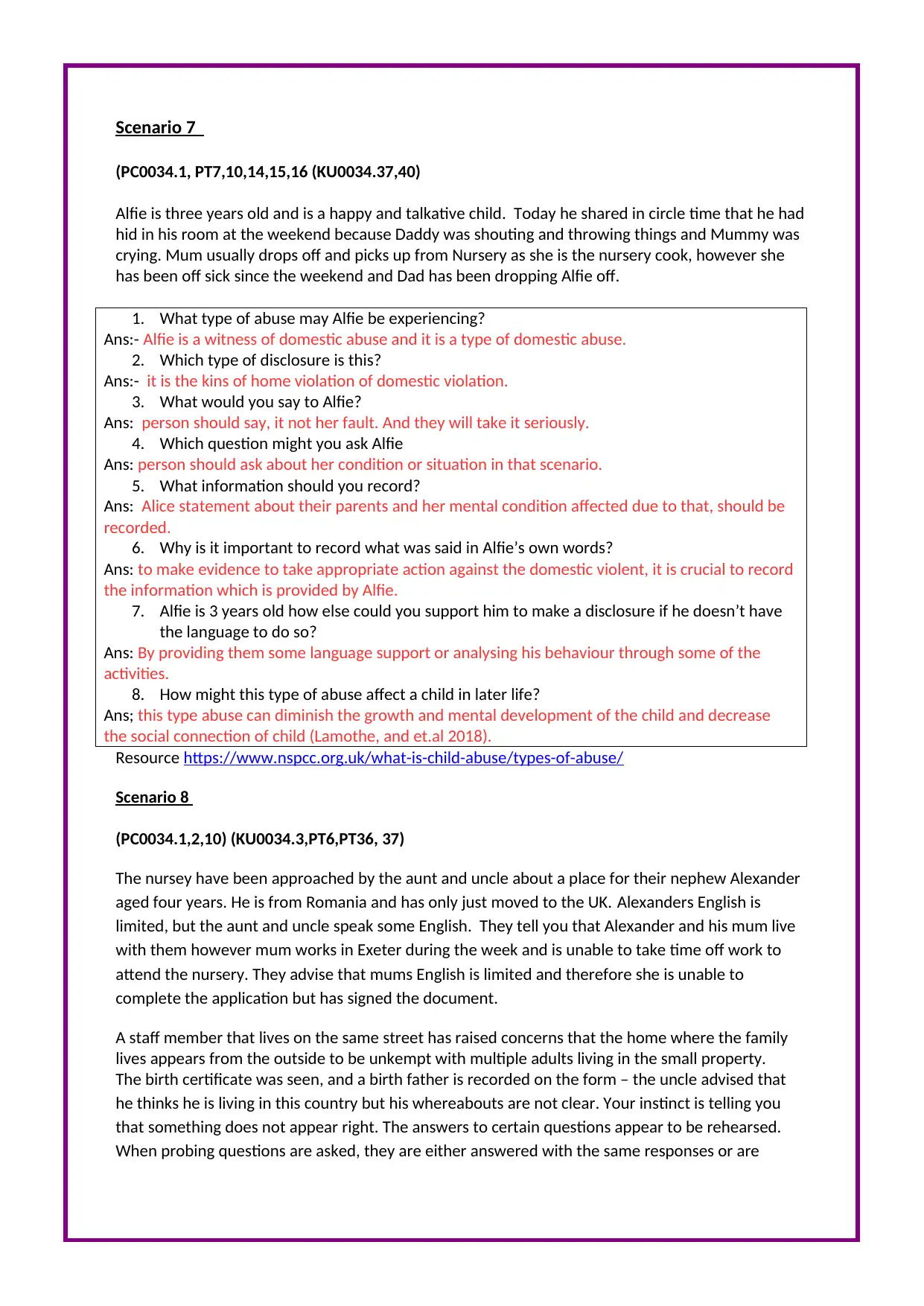
Scenario 7
(PC0034.1, PT7,10,14,15,16 (KU0034.37,40)
Alfie is three years old and is a happy and talkative child. Today he shared in circle time that he had
hid in his room at the weekend because Daddy was shouting and throwing things and Mummy was
crying. Mum usually drops off and picks up from Nursery as she is the nursery cook, however she
has been off sick since the weekend and Dad has been dropping Alfie off.
1. What type of abuse may Alfie be experiencing?
Ans:- Alfie is a witness of domestic abuse and it is a type of domestic abuse.
2. Which type of disclosure is this?
Ans:- it is the kins of home violation of domestic violation.
3. What would you say to Alfie?
Ans: person should say, it not her fault. And they will take it seriously.
4. Which question might you ask Alfie
Ans: person should ask about her condition or situation in that scenario.
5. What information should you record?
Ans: Alice statement about their parents and her mental condition affected due to that, should be
recorded.
6. Why is it important to record what was said in Alfie’s own words?
Ans: to make evidence to take appropriate action against the domestic violent, it is crucial to record
the information which is provided by Alfie.
7. Alfie is 3 years old how else could you support him to make a disclosure if he doesn’t have
the language to do so?
Ans: By providing them some language support or analysing his behaviour through some of the
activities.
8. How might this type of abuse affect a child in later life?
Ans; this type abuse can diminish the growth and mental development of the child and decrease
the social connection of child (Lamothe, and et.al 2018).
Resource https://www.nspcc.org.uk/what-is-child-abuse/types-of-abuse/
Scenario 8
(PC0034.1,2,10) (KU0034.3,PT6,PT36, 37)
The nursey have been approached by the aunt and uncle about a place for their nephew Alexander
aged four years. He is from Romania and has only just moved to the UK. Alexanders English is
limited, but the aunt and uncle speak some English. They tell you that Alexander and his mum live
with them however mum works in Exeter during the week and is unable to take time off work to
attend the nursery. They advise that mums English is limited and therefore she is unable to
complete the application but has signed the document.
A staff member that lives on the same street has raised concerns that the home where the family
lives appears from the outside to be unkempt with multiple adults living in the small property.
The birth certificate was seen, and a birth father is recorded on the form – the uncle advised that
he thinks he is living in this country but his whereabouts are not clear. Your instinct is telling you
that something does not appear right. The answers to certain questions appear to be rehearsed.
When probing questions are asked, they are either answered with the same responses or are
(PC0034.1, PT7,10,14,15,16 (KU0034.37,40)
Alfie is three years old and is a happy and talkative child. Today he shared in circle time that he had
hid in his room at the weekend because Daddy was shouting and throwing things and Mummy was
crying. Mum usually drops off and picks up from Nursery as she is the nursery cook, however she
has been off sick since the weekend and Dad has been dropping Alfie off.
1. What type of abuse may Alfie be experiencing?
Ans:- Alfie is a witness of domestic abuse and it is a type of domestic abuse.
2. Which type of disclosure is this?
Ans:- it is the kins of home violation of domestic violation.
3. What would you say to Alfie?
Ans: person should say, it not her fault. And they will take it seriously.
4. Which question might you ask Alfie
Ans: person should ask about her condition or situation in that scenario.
5. What information should you record?
Ans: Alice statement about their parents and her mental condition affected due to that, should be
recorded.
6. Why is it important to record what was said in Alfie’s own words?
Ans: to make evidence to take appropriate action against the domestic violent, it is crucial to record
the information which is provided by Alfie.
7. Alfie is 3 years old how else could you support him to make a disclosure if he doesn’t have
the language to do so?
Ans: By providing them some language support or analysing his behaviour through some of the
activities.
8. How might this type of abuse affect a child in later life?
Ans; this type abuse can diminish the growth and mental development of the child and decrease
the social connection of child (Lamothe, and et.al 2018).
Resource https://www.nspcc.org.uk/what-is-child-abuse/types-of-abuse/
Scenario 8
(PC0034.1,2,10) (KU0034.3,PT6,PT36, 37)
The nursey have been approached by the aunt and uncle about a place for their nephew Alexander
aged four years. He is from Romania and has only just moved to the UK. Alexanders English is
limited, but the aunt and uncle speak some English. They tell you that Alexander and his mum live
with them however mum works in Exeter during the week and is unable to take time off work to
attend the nursery. They advise that mums English is limited and therefore she is unable to
complete the application but has signed the document.
A staff member that lives on the same street has raised concerns that the home where the family
lives appears from the outside to be unkempt with multiple adults living in the small property.
The birth certificate was seen, and a birth father is recorded on the form – the uncle advised that
he thinks he is living in this country but his whereabouts are not clear. Your instinct is telling you
that something does not appear right. The answers to certain questions appear to be rehearsed.
When probing questions are asked, they are either answered with the same responses or are
Paraphrase This Document
Need a fresh take? Get an instant paraphrase of this document with our AI Paraphraser
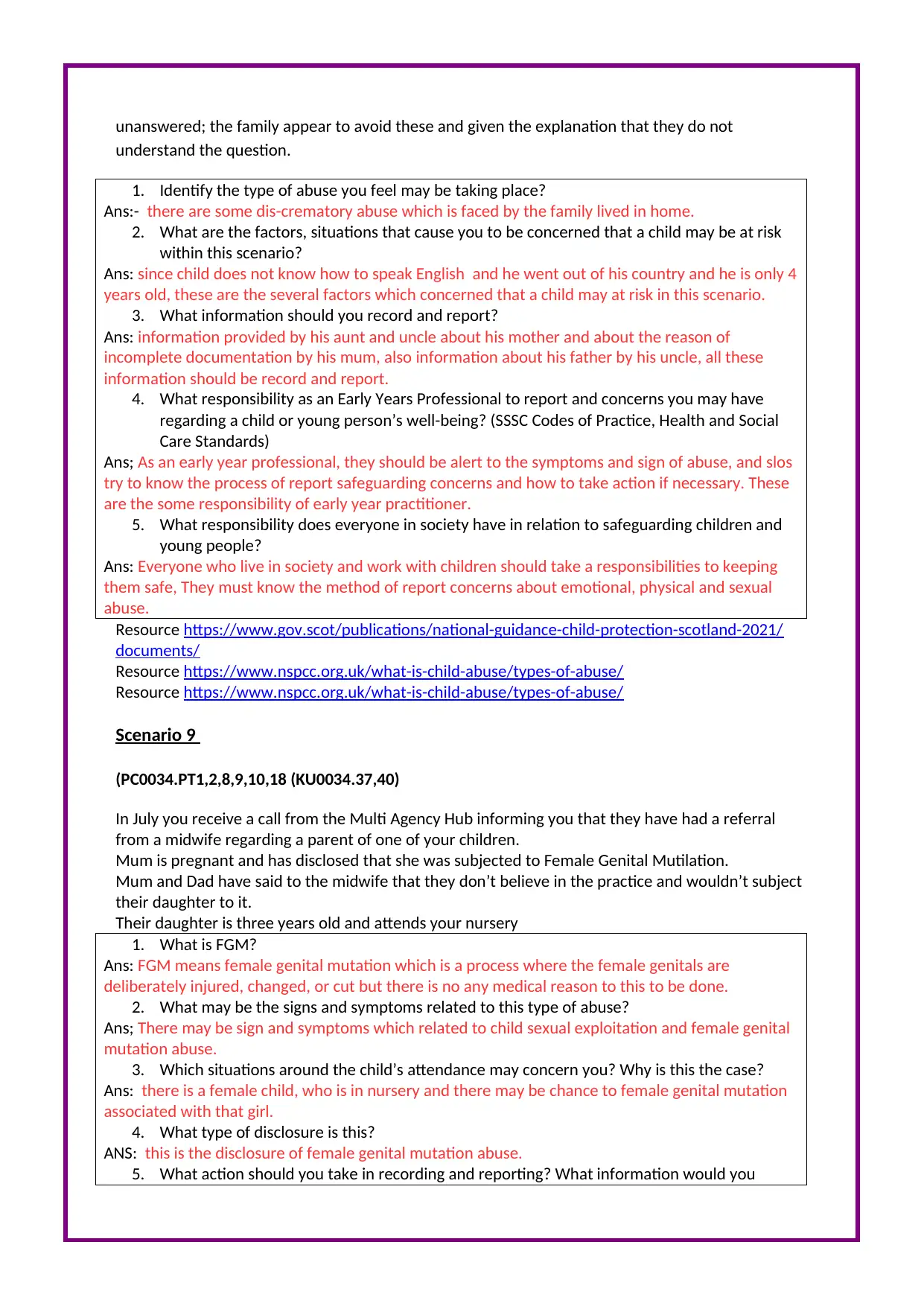
unanswered; the family appear to avoid these and given the explanation that they do not
understand the question.
1. Identify the type of abuse you feel may be taking place?
Ans:- there are some dis-crematory abuse which is faced by the family lived in home.
2. What are the factors, situations that cause you to be concerned that a child may be at risk
within this scenario?
Ans: since child does not know how to speak English and he went out of his country and he is only 4
years old, these are the several factors which concerned that a child may at risk in this scenario.
3. What information should you record and report?
Ans: information provided by his aunt and uncle about his mother and about the reason of
incomplete documentation by his mum, also information about his father by his uncle, all these
information should be record and report.
4. What responsibility as an Early Years Professional to report and concerns you may have
regarding a child or young person’s well-being? (SSSC Codes of Practice, Health and Social
Care Standards)
Ans; As an early year professional, they should be alert to the symptoms and sign of abuse, and slos
try to know the process of report safeguarding concerns and how to take action if necessary. These
are the some responsibility of early year practitioner.
5. What responsibility does everyone in society have in relation to safeguarding children and
young people?
Ans: Everyone who live in society and work with children should take a responsibilities to keeping
them safe, They must know the method of report concerns about emotional, physical and sexual
abuse.
Resource https://www.gov.scot/publications/national-guidance-child-protection-scotland-2021/
documents/
Resource https://www.nspcc.org.uk/what-is-child-abuse/types-of-abuse/
Resource https://www.nspcc.org.uk/what-is-child-abuse/types-of-abuse/
Scenario 9
(PC0034.PT1,2,8,9,10,18 (KU0034.37,40)
In July you receive a call from the Multi Agency Hub informing you that they have had a referral
from a midwife regarding a parent of one of your children.
Mum is pregnant and has disclosed that she was subjected to Female Genital Mutilation.
Mum and Dad have said to the midwife that they don’t believe in the practice and wouldn’t subject
their daughter to it.
Their daughter is three years old and attends your nursery
1. What is FGM?
Ans: FGM means female genital mutation which is a process where the female genitals are
deliberately injured, changed, or cut but there is no any medical reason to this to be done.
2. What may be the signs and symptoms related to this type of abuse?
Ans; There may be sign and symptoms which related to child sexual exploitation and female genital
mutation abuse.
3. Which situations around the child’s attendance may concern you? Why is this the case?
Ans: there is a female child, who is in nursery and there may be chance to female genital mutation
associated with that girl.
4. What type of disclosure is this?
ANS: this is the disclosure of female genital mutation abuse.
5. What action should you take in recording and reporting? What information would you
understand the question.
1. Identify the type of abuse you feel may be taking place?
Ans:- there are some dis-crematory abuse which is faced by the family lived in home.
2. What are the factors, situations that cause you to be concerned that a child may be at risk
within this scenario?
Ans: since child does not know how to speak English and he went out of his country and he is only 4
years old, these are the several factors which concerned that a child may at risk in this scenario.
3. What information should you record and report?
Ans: information provided by his aunt and uncle about his mother and about the reason of
incomplete documentation by his mum, also information about his father by his uncle, all these
information should be record and report.
4. What responsibility as an Early Years Professional to report and concerns you may have
regarding a child or young person’s well-being? (SSSC Codes of Practice, Health and Social
Care Standards)
Ans; As an early year professional, they should be alert to the symptoms and sign of abuse, and slos
try to know the process of report safeguarding concerns and how to take action if necessary. These
are the some responsibility of early year practitioner.
5. What responsibility does everyone in society have in relation to safeguarding children and
young people?
Ans: Everyone who live in society and work with children should take a responsibilities to keeping
them safe, They must know the method of report concerns about emotional, physical and sexual
abuse.
Resource https://www.gov.scot/publications/national-guidance-child-protection-scotland-2021/
documents/
Resource https://www.nspcc.org.uk/what-is-child-abuse/types-of-abuse/
Resource https://www.nspcc.org.uk/what-is-child-abuse/types-of-abuse/
Scenario 9
(PC0034.PT1,2,8,9,10,18 (KU0034.37,40)
In July you receive a call from the Multi Agency Hub informing you that they have had a referral
from a midwife regarding a parent of one of your children.
Mum is pregnant and has disclosed that she was subjected to Female Genital Mutilation.
Mum and Dad have said to the midwife that they don’t believe in the practice and wouldn’t subject
their daughter to it.
Their daughter is three years old and attends your nursery
1. What is FGM?
Ans: FGM means female genital mutation which is a process where the female genitals are
deliberately injured, changed, or cut but there is no any medical reason to this to be done.
2. What may be the signs and symptoms related to this type of abuse?
Ans; There may be sign and symptoms which related to child sexual exploitation and female genital
mutation abuse.
3. Which situations around the child’s attendance may concern you? Why is this the case?
Ans: there is a female child, who is in nursery and there may be chance to female genital mutation
associated with that girl.
4. What type of disclosure is this?
ANS: this is the disclosure of female genital mutation abuse.
5. What action should you take in recording and reporting? What information would you
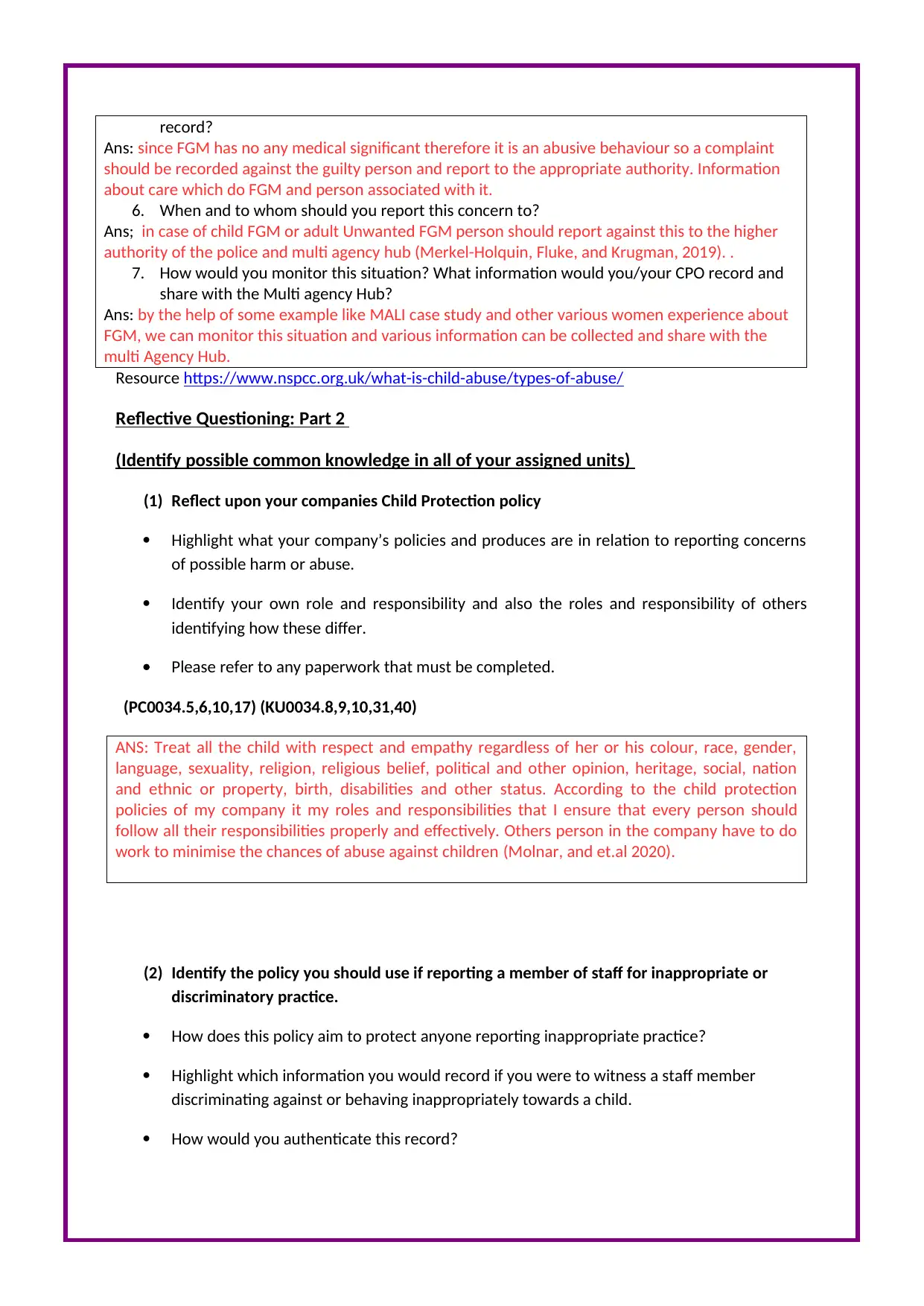
record?
Ans: since FGM has no any medical significant therefore it is an abusive behaviour so a complaint
should be recorded against the guilty person and report to the appropriate authority. Information
about care which do FGM and person associated with it.
6. When and to whom should you report this concern to?
Ans; in case of child FGM or adult Unwanted FGM person should report against this to the higher
authority of the police and multi agency hub (Merkel-Holquin, Fluke, and Krugman, 2019). .
7. How would you monitor this situation? What information would you/your CPO record and
share with the Multi agency Hub?
Ans: by the help of some example like MALI case study and other various women experience about
FGM, we can monitor this situation and various information can be collected and share with the
multi Agency Hub.
Resource https://www.nspcc.org.uk/what-is-child-abuse/types-of-abuse/
Reflective Questioning: Part 2
(Identify possible common knowledge in all of your assigned units)
(1) Reflect upon your companies Child Protection policy
Highlight what your company’s policies and produces are in relation to reporting concerns
of possible harm or abuse.
Identify your own role and responsibility and also the roles and responsibility of others
identifying how these differ.
Please refer to any paperwork that must be completed.
(PC0034.5,6,10,17) (KU0034.8,9,10,31,40)
ANS: Treat all the child with respect and empathy regardless of her or his colour, race, gender,
language, sexuality, religion, religious belief, political and other opinion, heritage, social, nation
and ethnic or property, birth, disabilities and other status. According to the child protection
policies of my company it my roles and responsibilities that I ensure that every person should
follow all their responsibilities properly and effectively. Others person in the company have to do
work to minimise the chances of abuse against children (Molnar, and et.al 2020).
(2) Identify the policy you should use if reporting a member of staff for inappropriate or
discriminatory practice.
How does this policy aim to protect anyone reporting inappropriate practice?
Highlight which information you would record if you were to witness a staff member
discriminating against or behaving inappropriately towards a child.
How would you authenticate this record?
Ans: since FGM has no any medical significant therefore it is an abusive behaviour so a complaint
should be recorded against the guilty person and report to the appropriate authority. Information
about care which do FGM and person associated with it.
6. When and to whom should you report this concern to?
Ans; in case of child FGM or adult Unwanted FGM person should report against this to the higher
authority of the police and multi agency hub (Merkel-Holquin, Fluke, and Krugman, 2019). .
7. How would you monitor this situation? What information would you/your CPO record and
share with the Multi agency Hub?
Ans: by the help of some example like MALI case study and other various women experience about
FGM, we can monitor this situation and various information can be collected and share with the
multi Agency Hub.
Resource https://www.nspcc.org.uk/what-is-child-abuse/types-of-abuse/
Reflective Questioning: Part 2
(Identify possible common knowledge in all of your assigned units)
(1) Reflect upon your companies Child Protection policy
Highlight what your company’s policies and produces are in relation to reporting concerns
of possible harm or abuse.
Identify your own role and responsibility and also the roles and responsibility of others
identifying how these differ.
Please refer to any paperwork that must be completed.
(PC0034.5,6,10,17) (KU0034.8,9,10,31,40)
ANS: Treat all the child with respect and empathy regardless of her or his colour, race, gender,
language, sexuality, religion, religious belief, political and other opinion, heritage, social, nation
and ethnic or property, birth, disabilities and other status. According to the child protection
policies of my company it my roles and responsibilities that I ensure that every person should
follow all their responsibilities properly and effectively. Others person in the company have to do
work to minimise the chances of abuse against children (Molnar, and et.al 2020).
(2) Identify the policy you should use if reporting a member of staff for inappropriate or
discriminatory practice.
How does this policy aim to protect anyone reporting inappropriate practice?
Highlight which information you would record if you were to witness a staff member
discriminating against or behaving inappropriately towards a child.
How would you authenticate this record?
⊘ This is a preview!⊘
Do you want full access?
Subscribe today to unlock all pages.

Trusted by 1+ million students worldwide
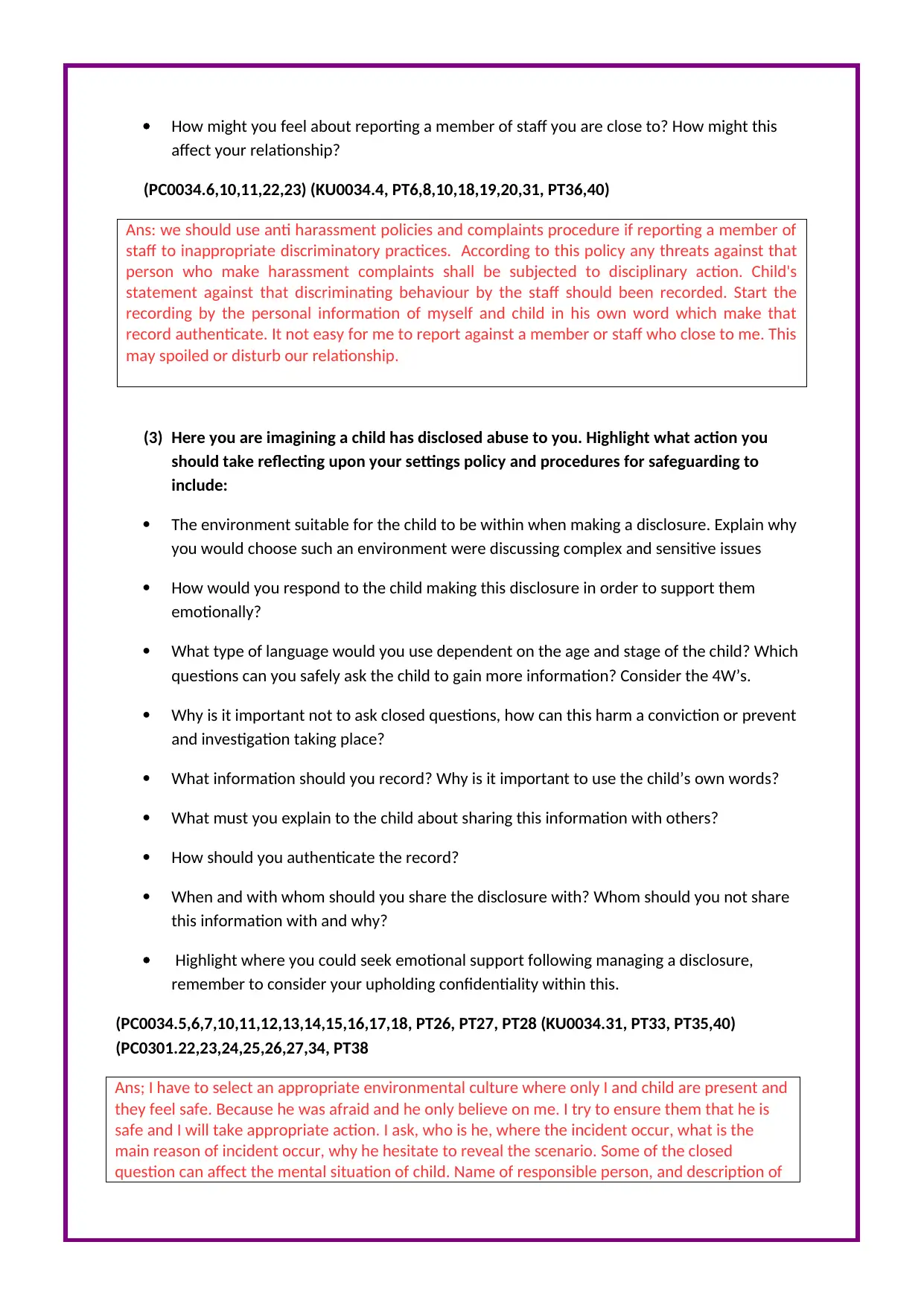
How might you feel about reporting a member of staff you are close to? How might this
affect your relationship?
(PC0034.6,10,11,22,23) (KU0034.4, PT6,8,10,18,19,20,31, PT36,40)
Ans: we should use anti harassment policies and complaints procedure if reporting a member of
staff to inappropriate discriminatory practices. According to this policy any threats against that
person who make harassment complaints shall be subjected to disciplinary action. Child's
statement against that discriminating behaviour by the staff should been recorded. Start the
recording by the personal information of myself and child in his own word which make that
record authenticate. It not easy for me to report against a member or staff who close to me. This
may spoiled or disturb our relationship.
(3) Here you are imagining a child has disclosed abuse to you. Highlight what action you
should take reflecting upon your settings policy and procedures for safeguarding to
include:
The environment suitable for the child to be within when making a disclosure. Explain why
you would choose such an environment were discussing complex and sensitive issues
How would you respond to the child making this disclosure in order to support them
emotionally?
What type of language would you use dependent on the age and stage of the child? Which
questions can you safely ask the child to gain more information? Consider the 4W’s.
Why is it important not to ask closed questions, how can this harm a conviction or prevent
and investigation taking place?
What information should you record? Why is it important to use the child’s own words?
What must you explain to the child about sharing this information with others?
How should you authenticate the record?
When and with whom should you share the disclosure with? Whom should you not share
this information with and why?
Highlight where you could seek emotional support following managing a disclosure,
remember to consider your upholding confidentiality within this.
(PC0034.5,6,7,10,11,12,13,14,15,16,17,18, PT26, PT27, PT28 (KU0034.31, PT33, PT35,40)
(PC0301.22,23,24,25,26,27,34, PT38
Ans; I have to select an appropriate environmental culture where only I and child are present and
they feel safe. Because he was afraid and he only believe on me. I try to ensure them that he is
safe and I will take appropriate action. I ask, who is he, where the incident occur, what is the
main reason of incident occur, why he hesitate to reveal the scenario. Some of the closed
question can affect the mental situation of child. Name of responsible person, and description of
affect your relationship?
(PC0034.6,10,11,22,23) (KU0034.4, PT6,8,10,18,19,20,31, PT36,40)
Ans: we should use anti harassment policies and complaints procedure if reporting a member of
staff to inappropriate discriminatory practices. According to this policy any threats against that
person who make harassment complaints shall be subjected to disciplinary action. Child's
statement against that discriminating behaviour by the staff should been recorded. Start the
recording by the personal information of myself and child in his own word which make that
record authenticate. It not easy for me to report against a member or staff who close to me. This
may spoiled or disturb our relationship.
(3) Here you are imagining a child has disclosed abuse to you. Highlight what action you
should take reflecting upon your settings policy and procedures for safeguarding to
include:
The environment suitable for the child to be within when making a disclosure. Explain why
you would choose such an environment were discussing complex and sensitive issues
How would you respond to the child making this disclosure in order to support them
emotionally?
What type of language would you use dependent on the age and stage of the child? Which
questions can you safely ask the child to gain more information? Consider the 4W’s.
Why is it important not to ask closed questions, how can this harm a conviction or prevent
and investigation taking place?
What information should you record? Why is it important to use the child’s own words?
What must you explain to the child about sharing this information with others?
How should you authenticate the record?
When and with whom should you share the disclosure with? Whom should you not share
this information with and why?
Highlight where you could seek emotional support following managing a disclosure,
remember to consider your upholding confidentiality within this.
(PC0034.5,6,7,10,11,12,13,14,15,16,17,18, PT26, PT27, PT28 (KU0034.31, PT33, PT35,40)
(PC0301.22,23,24,25,26,27,34, PT38
Ans; I have to select an appropriate environmental culture where only I and child are present and
they feel safe. Because he was afraid and he only believe on me. I try to ensure them that he is
safe and I will take appropriate action. I ask, who is he, where the incident occur, what is the
main reason of incident occur, why he hesitate to reveal the scenario. Some of the closed
question can affect the mental situation of child. Name of responsible person, and description of
Paraphrase This Document
Need a fresh take? Get an instant paraphrase of this document with our AI Paraphraser
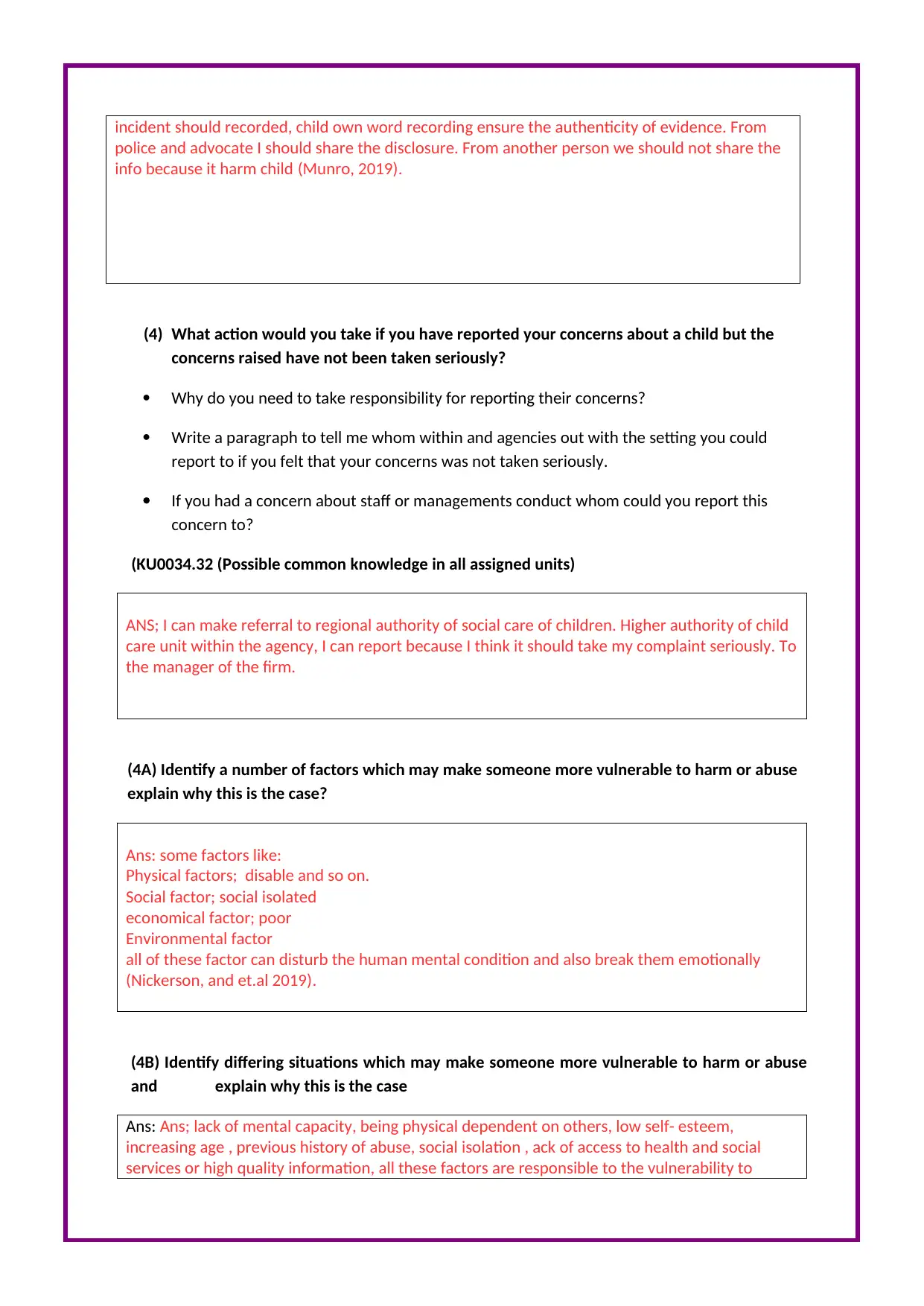
incident should recorded, child own word recording ensure the authenticity of evidence. From
police and advocate I should share the disclosure. From another person we should not share the
info because it harm child (Munro, 2019).
(4) What action would you take if you have reported your concerns about a child but the
concerns raised have not been taken seriously?
Why do you need to take responsibility for reporting their concerns?
Write a paragraph to tell me whom within and agencies out with the setting you could
report to if you felt that your concerns was not taken seriously.
If you had a concern about staff or managements conduct whom could you report this
concern to?
(KU0034.32 (Possible common knowledge in all assigned units)
ANS; I can make referral to regional authority of social care of children. Higher authority of child
care unit within the agency, I can report because I think it should take my complaint seriously. To
the manager of the firm.
(4A) Identify a number of factors which may make someone more vulnerable to harm or abuse
explain why this is the case?
Ans: some factors like:
Physical factors; disable and so on.
Social factor; social isolated
economical factor; poor
Environmental factor
all of these factor can disturb the human mental condition and also break them emotionally
(Nickerson, and et.al 2019).
(4B) Identify differing situations which may make someone more vulnerable to harm or abuse
and explain why this is the case
Ans: Ans; lack of mental capacity, being physical dependent on others, low self- esteem,
increasing age , previous history of abuse, social isolation , ack of access to health and social
services or high quality information, all these factors are responsible to the vulnerability to
police and advocate I should share the disclosure. From another person we should not share the
info because it harm child (Munro, 2019).
(4) What action would you take if you have reported your concerns about a child but the
concerns raised have not been taken seriously?
Why do you need to take responsibility for reporting their concerns?
Write a paragraph to tell me whom within and agencies out with the setting you could
report to if you felt that your concerns was not taken seriously.
If you had a concern about staff or managements conduct whom could you report this
concern to?
(KU0034.32 (Possible common knowledge in all assigned units)
ANS; I can make referral to regional authority of social care of children. Higher authority of child
care unit within the agency, I can report because I think it should take my complaint seriously. To
the manager of the firm.
(4A) Identify a number of factors which may make someone more vulnerable to harm or abuse
explain why this is the case?
Ans: some factors like:
Physical factors; disable and so on.
Social factor; social isolated
economical factor; poor
Environmental factor
all of these factor can disturb the human mental condition and also break them emotionally
(Nickerson, and et.al 2019).
(4B) Identify differing situations which may make someone more vulnerable to harm or abuse
and explain why this is the case
Ans: Ans; lack of mental capacity, being physical dependent on others, low self- esteem,
increasing age , previous history of abuse, social isolation , ack of access to health and social
services or high quality information, all these factors are responsible to the vulnerability to
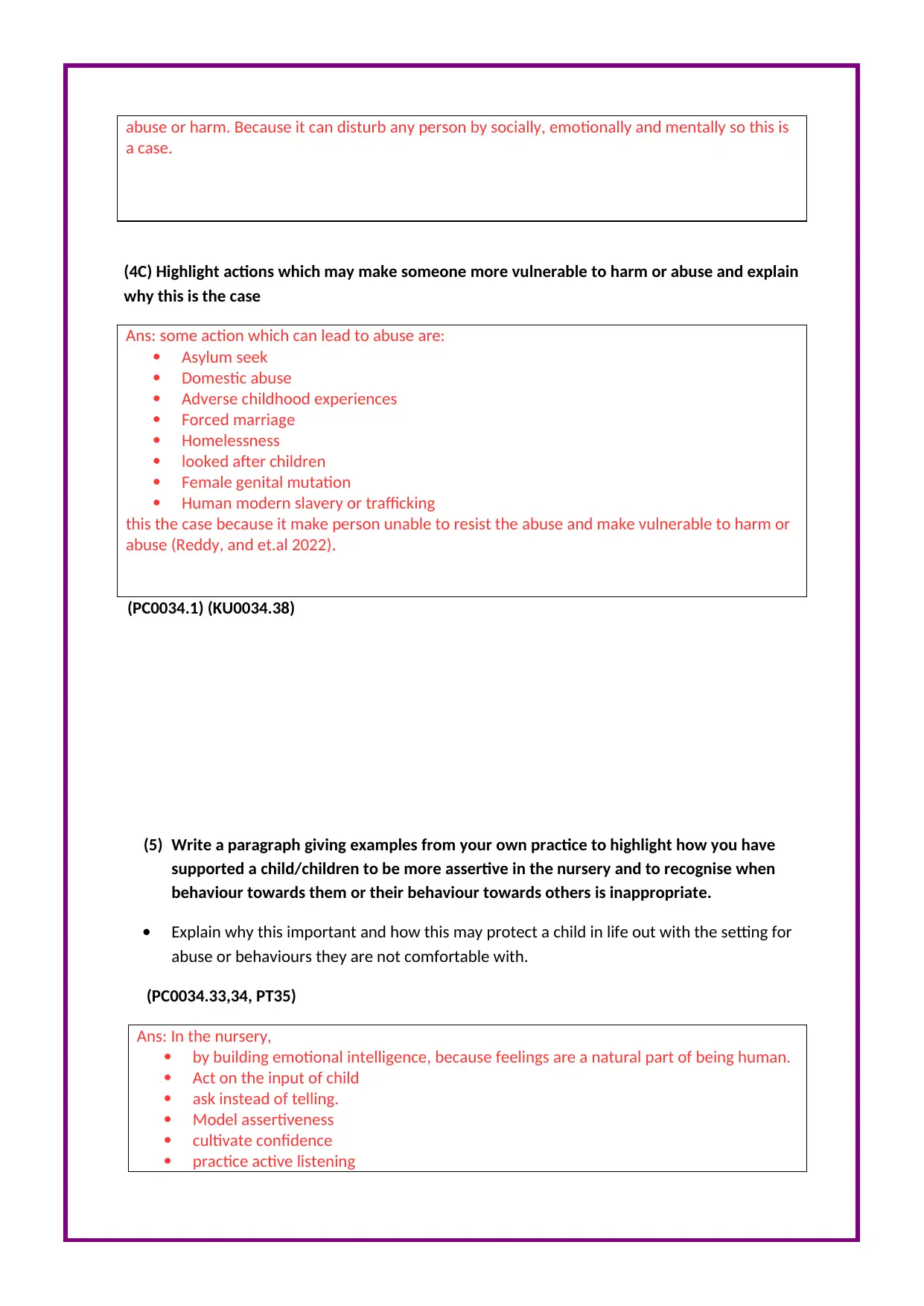
abuse or harm. Because it can disturb any person by socially, emotionally and mentally so this is
a case.
(4C) Highlight actions which may make someone more vulnerable to harm or abuse and explain
why this is the case
Ans: some action which can lead to abuse are:
Asylum seek
Domestic abuse
Adverse childhood experiences
Forced marriage
Homelessness
looked after children
Female genital mutation
Human modern slavery or trafficking
this the case because it make person unable to resist the abuse and make vulnerable to harm or
abuse (Reddy, and et.al 2022).
(PC0034.1) (KU0034.38)
(5) Write a paragraph giving examples from your own practice to highlight how you have
supported a child/children to be more assertive in the nursery and to recognise when
behaviour towards them or their behaviour towards others is inappropriate.
Explain why this important and how this may protect a child in life out with the setting for
abuse or behaviours they are not comfortable with.
(PC0034.33,34, PT35)
Ans: In the nursery,
by building emotional intelligence, because feelings are a natural part of being human.
Act on the input of child
ask instead of telling.
Model assertiveness
cultivate confidence
practice active listening
a case.
(4C) Highlight actions which may make someone more vulnerable to harm or abuse and explain
why this is the case
Ans: some action which can lead to abuse are:
Asylum seek
Domestic abuse
Adverse childhood experiences
Forced marriage
Homelessness
looked after children
Female genital mutation
Human modern slavery or trafficking
this the case because it make person unable to resist the abuse and make vulnerable to harm or
abuse (Reddy, and et.al 2022).
(PC0034.1) (KU0034.38)
(5) Write a paragraph giving examples from your own practice to highlight how you have
supported a child/children to be more assertive in the nursery and to recognise when
behaviour towards them or their behaviour towards others is inappropriate.
Explain why this important and how this may protect a child in life out with the setting for
abuse or behaviours they are not comfortable with.
(PC0034.33,34, PT35)
Ans: In the nursery,
by building emotional intelligence, because feelings are a natural part of being human.
Act on the input of child
ask instead of telling.
Model assertiveness
cultivate confidence
practice active listening
⊘ This is a preview!⊘
Do you want full access?
Subscribe today to unlock all pages.

Trusted by 1+ million students worldwide
1 out of 19
Your All-in-One AI-Powered Toolkit for Academic Success.
+13062052269
info@desklib.com
Available 24*7 on WhatsApp / Email
![[object Object]](/_next/static/media/star-bottom.7253800d.svg)
Unlock your academic potential
Copyright © 2020–2025 A2Z Services. All Rights Reserved. Developed and managed by ZUCOL.

